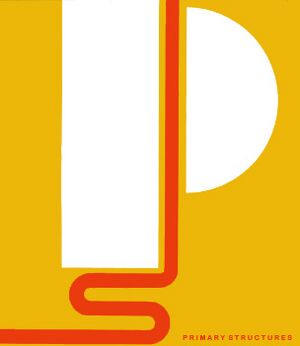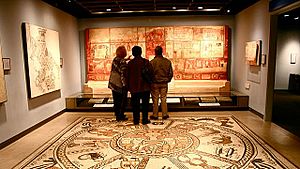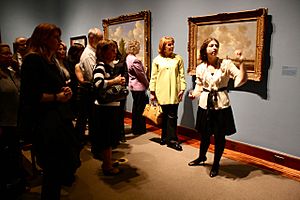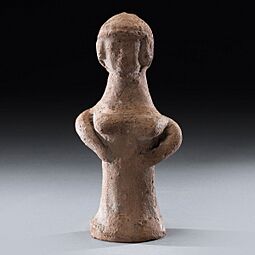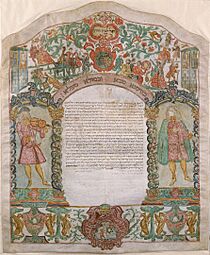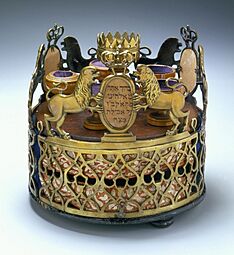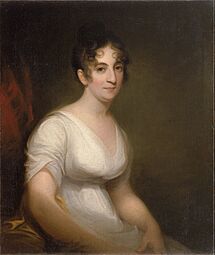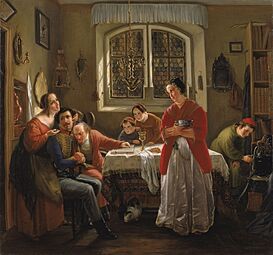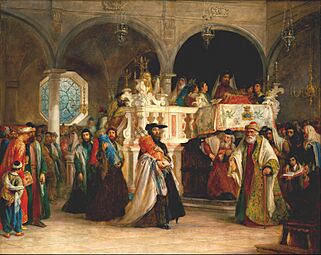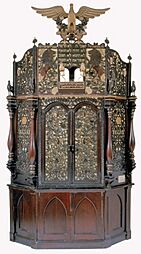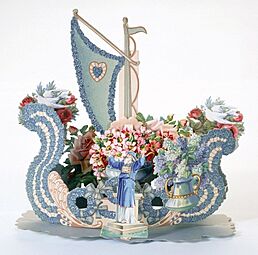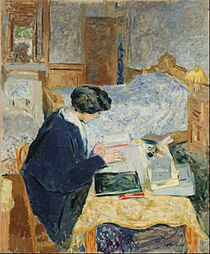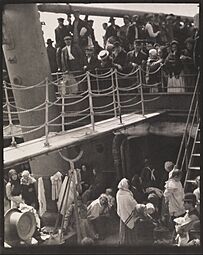Jewish Museum (Manhattan) facts for kids
 |
|
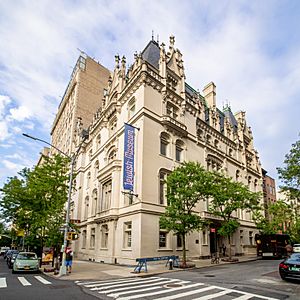
The Jewish Museum is housed in the Felix M. Warburg House.
|
|
| Lua error in Module:Location_map at line 420: attempt to index field 'wikibase' (a nil value). | |
| Established | 1904 |
|---|---|
| Location | 1109 Fifth Avenue at 92nd Street, Manhattan, New York |
| Type | Art Museum |
| Visitors | 110,000 (2023) |
| Architect | C. P. H. Gilbert |
| Public transit access | Subway: Bus: M1, M2, M3, M4, M86 |
The Jewish Museum is an art museum located on Fifth Avenue in New York City. It's part of the famous Museum Mile on the Upper East Side. The museum is housed in a beautiful building called the Felix M. Warburg House.
This museum has a huge collection of about 30,000 items. These include religious objects, fine art, and media. It's one of the biggest museums in the world focused on Jewish culture. The museum is known for its wide range of cultural and historical exhibits. It shows art that highlights "Jewish heritage and viewpoints" while also being interesting to everyone.
The Jewish Museum started in 1904. Judge Mayer Sulzberger donated many special objects to the Jewish Theological Seminary of America. The collection grew with more gifts. In 1939, during World War II, about 350 objects from Poland were sent to New York for safekeeping. The museum found its permanent home in the Warburg family mansion. Frieda Warburg donated the mansion in 1944, and the museum opened to the public in 1947. The building was designed by C. P. H. Gilbert in a castle-like style. It was expanded in 1959 and 1963.
Joy Ungerleider-Mayerson became director in 1972. She helped the museum get 600 ancient artifacts from Israel. She also oversaw the 1975 exhibit Jewish Experience in the Art of the 20th Century. Later, Joan Rosenbaum was director from 1981 to 2010. She started new public programs, like the New York Jewish Film Festival in 1992. The museum also had a big renovation in 1993 by Kevin Roche. This added more space for exhibits and education. In 2006, the museum started opening on Saturdays. Claudia Gould became director in 2011 and retired in 2023. James S. Snyder took over in November 2023.
Over the years, the Jewish Museum has been very important for modern and contemporary art in the United States. It was one of the first places to show works by famous artists like Helen Frankenthaler and Robert Rauschenberg. It also helped launch Minimalist sculpture with its important 1966 exhibition Primary Structures.
Contents
Museum History
How the Museum Began
The museum's collection started on January 20, 1904. Judge Mayer Sulzberger gave many Jewish ceremonial art objects to the Jewish Theological Seminary of America. These items were kept in the seminary's library. In 1931, the collection moved with the Seminary to a new location. The seminary received over 400 Jewish ceremonial items. This led to the creation of 'The Museum of Jewish Ceremonial Objects'.
The collection grew with large donations from Hadji Ephraim Benguiat and Harry G. Friedman. In 1939, during World War II, about 350 objects from homes and synagogues in Poland were sent to New York City. This was done to keep them safe from the war.
Finding a Permanent Home
After Felix Warburg, a rich banker, passed away in 1937, his wife, Frieda Schiff Warburg, donated their family mansion. In January 1944, she gave their Fifth Avenue home to the Jewish Theological Seminary. The purpose was to house the growing Jewish Museum collection. The museum officially opened to the public in May 1947.
When it opened, Frieda Warburg said the museum was not just about Jewish struggles. Instead, it was meant to celebrate Jewish culture, history, and traditions. At first, the museum focused on Jewish ceremonial and historical objects. This showed the seminary's interest in learning and preserving Jewish heritage after World War II.
In 1959, the museum added a sculpture garden. It was designed by artist Adam List. This new garden offered a place for modern sculptures and outdoor exhibits. A big expansion happened in 1963. This was to make room for the museum's growing collection and public programs. This expansion marked a new phase for the museum, making it more open to the public.
Focusing on Modern Art
In 1962, Alan R. Solomon, an art historian, became the museum's director. He brought a modern vision to the museum. Solomon wanted to show "the new art." He organized major exhibitions of rising American artists. These included Robert Rauschenberg, Jasper Johns, and Ellsworth Kelly. His programs focused on working with living artists. He also explored both Jewish themes and modern art after the war.
In 1963, he organized Rauschenberg's first big show. John's show followed in 1964. Solomon's time at the museum ended with a special project. The U.S. government asked him to organize the country's display at the 32nd Venice Biennale in 1964. There, Rauschenberg's work won a major award.
By the mid-1960s, the Jewish Museum became well-known in the modern art world. This brought public interest and also discussions about what the museum should be. The New York Times wrote an article in 1965 about the museum's direction. It talked about the balance between showing Jewish historical objects and modern art.
Curators Sam Hunter and Kynaston McShine continued to show modern art. McShine, who was a curator from 1965 to 1968, organized Primary Structures in 1966. This was a very important exhibition that introduced Minimalist sculpture to many people. It featured artists like Donald Judd and Carl Andre. In 1968, Karl Katz became the museum's director. This focus on new art continued with Katz's 1970 exhibition Software, which explored early digital art.
Later Years and Renovations
In 1971, the museum decided to stop showing art not related to the Jewish community. This was due to financial reasons. This decision led to Karl Katz leaving his role that year. The museum then focused more on Jewish identity and culture. Joy Ungerleider-Mayerson became director in 1972. She helped the museum get 600 ancient artifacts from Israel. A notable exhibition during her time was Jewish Experience in the Art of the 20th Century in 1975.
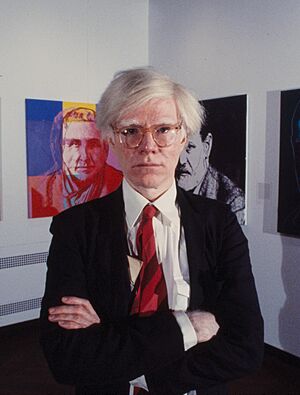
In 1980, the museum showed Andy Warhol's Ten Portraits of Jews of the 20th Century. This series of silk-screened paintings featured famous Jewish figures. These included Sigmund Freud and George Gershwin. The series was controversial at first, with some critics not liking it. However, it was later shown in many Jewish cultural places and synagogues across the United States.
From 1990 to 1993, director Joan Rosenbaum led a big project. She oversaw the renovation and expansion of the museum building. The project cost $60 million. Architect Kevin Roche designed the changes. The museum's size doubled, adding a seven-story section. In 1992, the Jewish Museum and the Film Society of Lincoln Center started The New York Jewish Film Festival together. This festival shows movies and documentaries.
In 1997, curator Norman Kleeblatt organized Too Jewish? Challenging Traditional Identities. This exhibit looked at Jewish identity in American culture after the war. It featured works by 23 artists. The show explored how stereotypes and self-image connect. It was controversial for some of its content. However, it was important for expanding discussions about Jewish identity in art.
The Museum Today
Today, the museum offers many educational programs for adults and families. These include concerts, films, talks, and lectures. It also has hands-on art activities and special programs for visitors with disabilities. Joan Rosenbaum was the museum's director until she retired in 2010. In 2006, the museum changed its policy. It started offering free public admission on Saturdays, breaking with its tradition of being closed for Sabbath observance. In 2011, Claudia Gould became the new director.
In 2020, the museum asked artist Lawrence Weiner to create a public artwork. He made a large banner for the museum's front. It said All the stars in the sky have the same face in English, Hebrew, and Arabic.
In November 2024, a new restaurant called Lox opened in the museum.
The Museum Building
The Felix M. Warburg House was built between 1906 and 1908. It was designed by C. P. H. Gilbert for Felix and Frieda Warburg. The style is called François I, which looks like a French castle. This style was popular in New York City in the late 1800s. Gilbert was a student of Richard Morris Hunt, a famous architect. Gilbert used Hunt's castle-like style for the Warburg house. He also added some Gothic features.
The original house is made of limestone with special roofs and carvings. This architectural style showed wealth. Felix Warburg wanted to impress his neighbors. The house used to have a green yard in front, which later became the museum's entrance.
Building Renovations

When the house became a museum, architect Kevin Roche was chosen to design additions. Roche also designed additions to the Metropolitan Museum of Art. After spending $36 million and two and a half years, Roche finished his additions in June 1993. He wanted his new parts to match the museum's Gothic revival style. This is clear in the Fifth Avenue front and the auditorium. The Fifth Avenue front is made of Indiana limestone and carved in a Gothic revival style.
The auditorium is in a ballroom that was updated to a Gothic revival style. It uses the mansion's stained-glass dome and screen. The cafe in the basement also has stained glass windows.
Even though Roche added Gothic revival features, he also made sure the museum felt modern. For example, he made sure the education center and auditorium had the right technology. This included interactive visual displays.
Museum Collections
The museum has almost 30,000 objects. These include paintings, sculptures, old artifacts from digs, Jewish ceremonial art, and many other pieces. All these items are important for preserving Jewish history and culture. Some artists in the museum's collection are James Tissot, Marc Chagall, George Segal, and Deborah Kass. This is the largest collection of Jewish art, Judaica, and media outside of museums in Israel.
The museum has a special exhibit called Scenes from the Collection. It shows art from ancient times to today. The museum's collection includes objects from different time periods and in all kinds of materials. These items come from all over the world where Jewish people have lived.
Public Programs
The Jewish Museum offers many public educational programs. These include talks, lectures, performances, and hands-on art activities. They also have group visits and special programs for visitors with disabilities. For example, there's a Verbal Description Tour once a month. During this program, visitors can explore parts of the empty museum. An art educator gives detailed descriptions of the artwork. They also let visitors touch some objects and encourage discussion. One visitor said it felt like "an honor" to touch the artwork.
The museum's programs are for many different people. They have live music and events just for children and families. Sometimes, events are co-sponsored with other museums on Fifth Avenue's Museum Mile. A goal of family programming is to attract younger visitors. Sundays are "family day" with many activities. These include gallery tours, free art workshops, and storybook readings for parents and children. Activities are designed to be interesting to all cultures and religions. They might explore topics like archaeological digs or the use of color in art.
Museum Management
Under Joan Rosenbaum's leadership, the museum's collection grew to 26,000 objects. Its money for the future grew to over $92 million. Its yearly budget increased from $1 million in 1981 to $15 million. Rosenbaum chose to focus on the Jewish side of the museum's identity. She created the permanent exhibition "Culture and Continuity: The Jewish Journey." She also put on shows of modern Jewish artists like Chaïm Soutine and contemporary artists like Maira Kalman. In 2013, the museum's board chose Claudia Gould as its new director.
In 2015, Kelly Taxter was named one of the top 25 female curators in the world by Artnet.
Highlights from the Collection
- Man Ray, Self-Portrait with Camera, 1930
- Andy Warhol, Ten Portraits of Jews of the 20th Century, 1980
- Eva Hesse, Untitled, 1963–64
- Richard Avedon, Jacob Israel Avedon portraits, 1969–73
- Adolph Gottlieb, Return of the Mariner, 1946
- Deborah Kass, Double Red Yentl, Split, from My Elvis series, 1993
- Jan Pogorzelski, Hanukkah menorah, 1893
- James Tissot, Adam and Eve Driven From Paradise, c. 1896–1902
- Alfred Stieglitz, The Steerage, 1907
- Reuven Rubin, Goldfish Vendor, 1928
- Marc Chagall, Old Man with Beard, c. 1931
- Johann Adam Boller Hanukkah menorah, Frankfurt am Main (Germany), 1706–32
- Torah Ark from Adath Yeshurun Synagogue, Abraham Shulkin, 1899
Selected Art Exhibitions
Some of the museum's important exhibitions have included:
- Primary Structures (1966)
- The Circle of Montparnasse: Jewish Artists in Paris, 1905–1945 (1985)
- The Dreyfus Affair: Art, Truth, and Justice (1987)
- Painting a Place in America: Jewish Artists in New York, 1900–1945 (1991)
- Too Jewish?: Challenging Traditional Identities (1996)
- Assignment: Rescue, The Story of Varian Fry and the Emergency Rescue Committee (1997)
- An Expressionist in Paris: The Paintings of Chaïm Soutine (1998)
- Voice, Image, Gesture: Selections from The Jewish Museum's Collection, 1945–2000 (2001)
- Mirroring Evil: Nazi Imagery/Recent Art (2002)
- New York: Capital of Photography (2002)
- Modigliani Beyond the Myth (2004)
- Eva Hesse: Sculpture (2006)
- Action/Abstraction: Pollock, de Kooning, and American Art, 1940–1976 (2008)
- Shifting the Gaze: Painting and Feminism (2010–2011)
- Harry Houdini: Art and Magic (2010–2011)
- Maira Kalman: Various Illuminations (of a Crazy World) (2011)
- Collecting Matisse and Modern Masters: The Cone sisters of Baltimore (2011)
- The Radical Camera: New York's Photo League, 1936–1951 (2012)
- The Snowy Day and the Art of Ezra Jack Keats (2012)
- Kehinde Wiley / The World Stage: Israel (2012)
- Édouard Vuillard: A Painter and His Muses, 1890–1940 (2012)
- "Crossing Borders: Manuscripts from the Bodleian Library" (September 14, 2012 – February 3, 2013)
- "Sharon Lockhart Noa Eshkol" (November 2, 2012 – March 24, 2013)
- Revolution of the Eye: Modern Art and the Birth of American Television (May 1 to September 27, 2015)
- "Pierre Chareau: Modern Architecture and Design" (November 4, 2016 – March 24, 2017)
- "Chagall, Lissitzky, Malevich: The Russian Avant-Garde in Vitebsk, 1918–1922" (September 14, 2018 – January 6, 2019)
- "The Sassoons" Exhibit from March 3 to August 13, 2023.
Gallery
-
Marriage contract, from Vercelli (Italy), 1776
-
Thomas Sully, Portrait of Sally Etting, 1808
-
Solomon Alexander Hart, Simchat Torah at the Synagogue of Livorno, c. 1850
-
Edouard Vuillard, Lucy Hessel Reading, 1915
-
Alfred Stieglitz, The Steerage, 1907 (printed in 1915)
See also
 In Spanish: Museo Judío de Nueva York para niños
In Spanish: Museo Judío de Nueva York para niños


